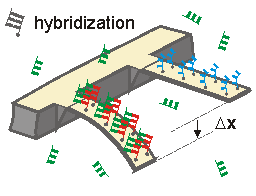Cram enough DNA molecules onto a tiny silicon diving board and the board will bend, a team of researchers in Switzerland has discovered. However, don’t expect the sinuous molecules—strings of chemical subunits, or bases, that spell out the genetic code—to then launch themselves into backflips or half gainers.

Different crowd-pleasing stunts lie in store, says Jürgen Fritz of the University of Basel and IBM’s Zurich Research Laboratory in Rüschlikon. In a study described in the April 14 Science, he and his colleagues show that the board-bending effect may provide a way to use molecular reactions, such as the binding of DNA strands, to power machines only micrometers in size.
Such reaction-driven devices might, for instance, someday autonomously open tiny drug dispensers in the bloodstream when they bind certain biomolecules, says Christoph Gerber of IBM Zurich, a leader of the new study.
“At the moment, to drive machinery you need a power supply,” says Fritz, a biophysicist who has just moved to the Massachusetts Institute of Technology. “Now, this power supply may come from these molecular interactions.”
“I think it’s a major result,” comments physicist Scott Manalis, who heads the MIT group that Fritz is joining. “What’s amazing is you’re bending an object by a molecular reaction.” Aside from that machine-operating potential, devices using the tiny diving boards, or cantilevers, might more immediately provide an alternative to conventional DNA chips (SN: 3/8/97, p. 144). Bending could indicate pathogens or harmful mutations, researchers say.
In their experiments, Fritz and his coworkers demonstrated the extreme sensitivity of a cantilever apparatus by showing that it discriminated between two 12-base strands of DNA differing only in the identity of one chemical base.
“It is pretty remarkable to get this sensitivity with a micromechanical device,” comments Calvin F. Quate of Stanford University. “It says a lot for the future of micromechanics.” In cells, DNA usually consists of two intertwined helical strands. Of the four DNA bases, known by the letters A, T, G, and C, an A on one strand always links with T on the other strand, and G always pairs with C. Two complementary single strands of DNA bind spontaneously and tightly when brought together.
To harness that reaction, the Swiss team used pairs of cantilevers, each 1 micrometer thick, 500 µm long, and coated on top with gold. Sulfur-containing molecules attached to the ends of single DNA strands bind to gold, so the researchers could create a forest of some 10 billion identical DNA pieces per cantilever. Each platform was planted with strands having a different sequence of bases.
Placing the cantilevers inside a fluid-filled box slightly larger than a sugar cube, the researchers added DNA that was complementary to the strands on one cantilever. As the new DNA joined the forest, it increased the crowding. This stretched the top cantilever surface—but not the bottom—causing the platform to bend, the scientists suspect. Because the added DNA didn’t bind to the strands on the other cantilever, that strip didn’t curve until its complementary DNA was provided.
Bending also took place in an experiment in which two proteins that interlock replaced the pairs of complementary DNA, the team reports.





